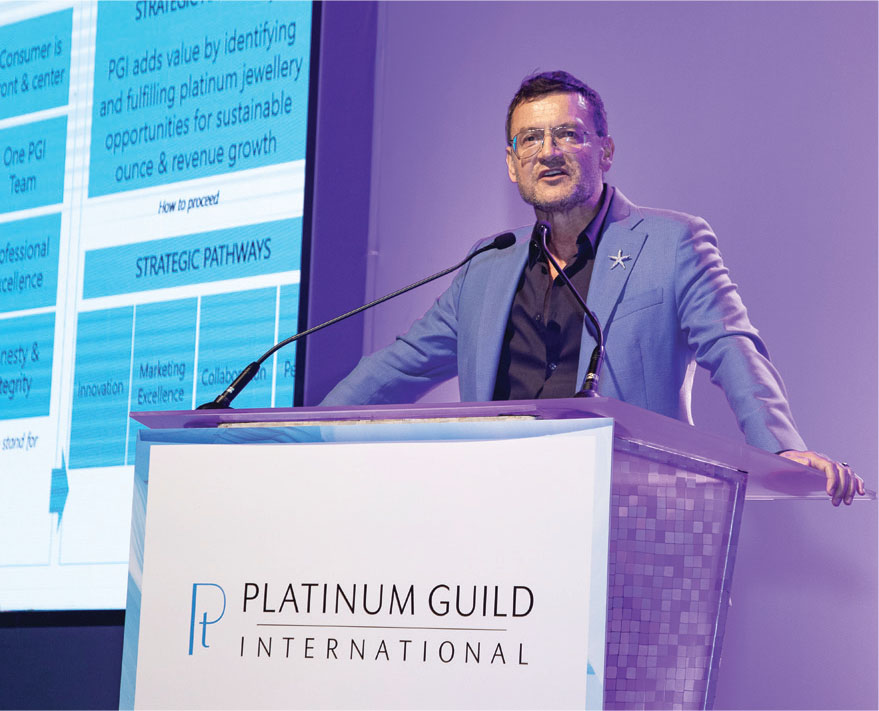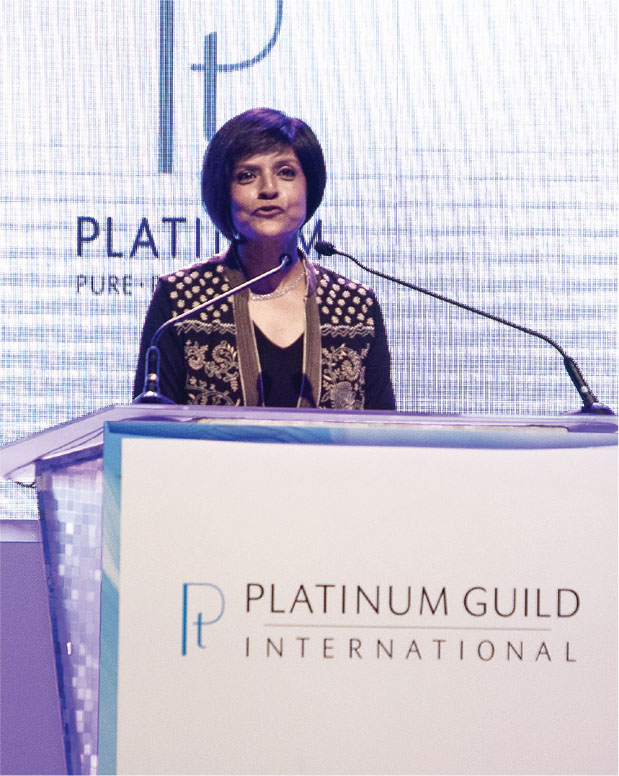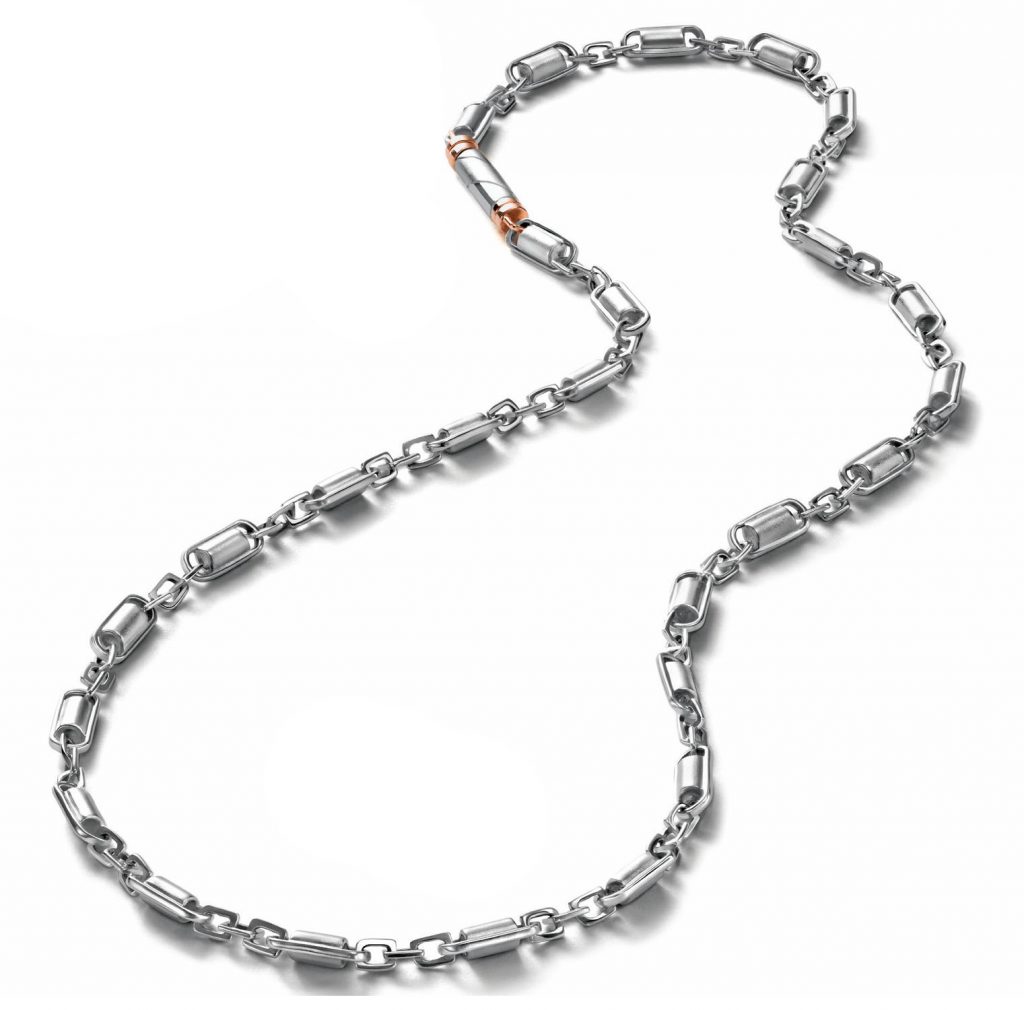Platinum is seen as a strong contender in terms of the choice of metal for jewellery in the coming future – a favourite of the younger generation for its subtlety and high design quotient. The platinum jewellery market in India is expected to grow 20-25% in volume by 2020. At the fourth edition of the Platinum Buyer-Seller Meet in Hyderabad, Platinum Guild International (PGI) India announced plans to increase its focus on the men’s jewellery category and help grow the market with the trendy ‘Men of Platinum’ jewellery line. SHANOO BIJLANI reports.
PGI India held the fourth edition of the Platinum Buyer-Seller Meet (BSM), an important platform for manufacturers and retailers to explore a wide range of platinum jewellery, in late July, in Hyderabad. Over 100 top retailers were invited to attend the threeday event and scour through curated collections offered by 10 renowned platinum manufacturers.
In an important announcement during the opening of the show, PGI India unveiled its new category dedicated to men’s jewellery – providing yet another opportunity to drive sales. Most of the visiting retailers were visibly enamoured by the men’s collections and were positive about the new category that could boost sales in the near future.
Benny Oeyen, executive head of market development, Anglo American, said that the launch of the men’s category is something the trade and market have been waiting for. “I am proud and excited about the launch, and if it works we could take this to other global markets as well.”
He added that in terms of platinum consumption, the automotive industry still stands at number one. “At number two is jewellery – with China being the biggest market, while India is small but mighty and growing. The future is looking great. The scope for platinum jewellery in the Indian market in the times to come is significant. It will never be as big as gold, and we don’t need it to be either. The whole premise of platinum is that it has to offer something different, both for the consumer and trade.”
The men’s jewellery category was launched after testing the market for almost two-and-ahalf years, informed Vaishali Banerjee, managing director, PGI India. “What started off as a small segment has grown into a sizable part of the retail business. This consumer segment is chased by industries such as automobiles, finance, apparel and others; and the reasons are many – this segment offers the highest affluence, the highest propensity to spend. It’s a segment with the maximum discretionary spending and offers high growth rates across categories. And we are very fortunate because we’ve spent the last couple of years testing our efforts in this segment with our retail partners,” Banerjee noted.
Huw Daniel, CEO, PGI, added, “Compared to other markets, there is already a strong base of the male jewellery market in India, because the culture here is much more accepting of jewellery than others. In terms of volume, there is a big potential for it to develop and that’s why we have entered into the men’s segment as we sense a much bigger opportunity.”
Lauding the launch of men’s category, Oeyen said that most of the participating manufacturers at the buyer-seller meet had looked into the masculine world and reinterpreted themes from different categories into jewellery.
PGI India has always been discovering opportunities to drive demand for platinum jewellery – be it the introduction of Love Bands, the highest selling platinum jewellery category across the country; Evara; Platinum Days of Love; and now Men’s Jewellery.
In a press meet, Banerjee noted, “We are creating desire for platinum, and are coming up with new jewellery-buying occasions for it. We have been growing retail distribution as well. From 1,300 doors at present, we aim to reach 1,800 doors by the end of this year.”
With platinum becoming cheaper than gold this season, will this mean that it gives an opportunity to retailers to convert a gold buyer to platinum? Banerjee responded, “Even though the gap between the two metals has reduced, the conversion price is one of the last things that come into play when you are buying platinum. Interestingly, platinum sells at a premium to gold at the retail counter. The desire for platinum is built on the back of the emotion attached to the metal, the storytelling and the design.”
Since platinum is still a young metal, it took a lot of effort in creating awareness about it in various markets. Despite the challenges, it has had a wonderful journey across the globe. Huw added, “It’s taken a lot of hand holding, a lot of education because you have got thousands of years of history and familiarity with gold, diamonds and semi-precious stones, and very little familiarity as a culture with platinum.
“When we introduced platinum into China in the early ’90s, there was no tradition of platinum. Since we wanted to position platinum as a serious precious metal which is both contemporary and unique, we could connect with the consumers. The big difference in the market was in terms of the business model – in China, it was a volume-based business; so it was priced in the same way gold was priced. In India, we took a very deliberate strategy by going on a piece-price basis. It is very difficult to build a new brand today without marketing and it is very difficult to build marketing without margins. So the model here I think is more sustainable.”
In response to a question about PGI targeting only new-age consumers, Huw replied, “Yes, our focus is always going to be towards the next generation of consumers. But we do have a very robust business in older age groups, and Japan is the best example. Consumers there typically have a minimum of 10 platinum pieces already in their jewellery box. There the challenge for us is about inventing new occasions, new reasons for those women to look at platinum again.
“However, we are conscious of the fact that you can’t really rely on that group alone; you have to be educating the new consumer even in Japan. Generally, I think, across the world it is fair to say that the younger generation has a lot more choices for what to spend money on. Jewellery, to some extent, has lost a little ground because other product categories are doing more aggressive marketing. So our focus is on the younger population, especially in America, China and India.”
Platinum jewellery has always thrived on design differentiation vis-à-vis gold. Generally, the global platinum trends are reinterpreted to suit the Indian aesthetic but in a contemporary way. The process of design selection is a very inclusive one, involving retailers and manufacturers.
Banerjee further explained that platinum will not enter the bridal segment because “the wedding day belongs to gold. It’s religious, it’s traditional, it’s ritualistic and we respect that. However, there are many other days to celebrate other occasions. One day can go to gold!” she said, adding, “We will actually encourage retailers to maximise the opportunities at their stores. We have created a host of days which is all about love and gifting.”




